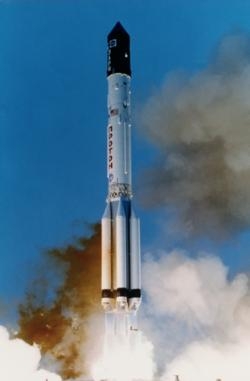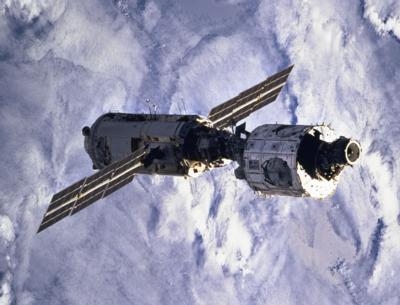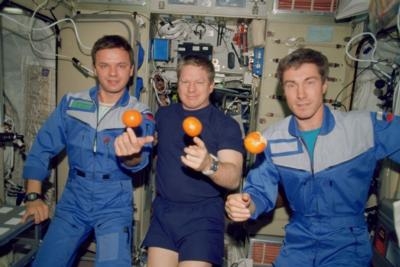First Module Of ISS Launched Into Orbit November 20, 1998
Nov. 20, 1998, was a day to mark in history. The Russian Space Agency, now known as Roscosmos, launched a Proton rocket that lifted the pressurized module called Zarya, or “sunrise,” into orbit. This launch would truly be the dawn of the largest international cooperation effort in space to ever come to light. Zarya was the first piece of the International Space Station. Also known as the Functional Cargo Block (FGB), it would provide a nucleus of orientation control, communications and electrical power while the station waited for its other elements, including the Zvezda service module and Unity.

“We were in the control center in Houston that night to watch Zarya launch, along with a good number of people from the program,” said Bill Bastedo, who is currently senior vice president of Booz Allen Hamilton. At the time, Bastedo had the technically demanding task of launch package manager for Unity, also known as Node 1. “It was actually, for us, exciting to have Zarya on orbit so we could get our chance to execute our mission.”
Two weeks later, on Dec. 4, 1998, NASA’s space shuttle Endeavour launched Unity, the first U.S. piece of the complex, during the STS-88 mission. The two space modules built on opposite sides of the planet were about to be joined together in space, making the space station truly international. STS-88 carries the distinction of being the first space station assembly mission, and Kennedy Space Center Director Bob Cabana was its commander. “We definitely knew there was no margin for error on that first mission—we had to be successful,” Cabana said. “We also knew that it wasn’t all on the crew. This was a team effort, and everyone was giving it all they had to ensure success. We had the privilege of following Node 1 from an aluminum shell…to a fully functioning spacecraft on orbit.”
Three years before Unity’s launch, Bastedo was leading the teams that developed Unity and its two pressurized mating adaptors. “We had to work closely with the Kennedy Space Center, the Space Shuttle Program Office and the Mission Operations Directorate (MOD) to plan the launch, on-orbit operations for the 14-day mission and define every detail of how we would assemble it on orbit,” Bastedo said.
With Unity being the first U.S. component of the space station, Bastedo’s teams and Cabana’s crew set the standard for future space station assembly missions. “I was very confident in our ability to dock the two,” Bastedo said. “I was most worried about making sure we could verify that Unity, the mating adaptors and Zarya all worked as a system together and we could safely leave it on orbit, because it was going to be about a six-month gap until the next flight. It turns out it was a lot of worry about nothing, because it almost went flawlessly.”

Since that first meeting of Zarya and Unity, the space station grew piece by piece with additions from each of the international partners built across three continents and leading to the largest and most complex spacecraft ever constructed.
The space station, now four times larger than Mir and five times larger than Skylab, represents a collaboration between NASA, Roscosmos, the European Space Agency, the Japanese Aerospace Exploration Agency and the Canadian Space Agency, representing 15 countries in all.
The first crew to inhabit the space station launched on a Soyuz spacecraft on Oct. 31, 2000, as Expedition 1 (pictured, below) and consisted of one NASA astronaut, Commander Bill Shepherd, and two Russian cosmonauts, Sergei Krikalev and Yuri Gidzenko. Their arrival on board the station Nov. 2 marked the start of a permanent human presence in space. The crew of Expedition 1 set the framework for international cooperation and attitude in space, displaying mutual respect and teamwork. Since the Expedition 1 crew’s example aboard the space station, there have been 37 expeditions following the same solidarity in space, working toward common goals. This makes the International Space Station home to the longest continuous human presence in space of all time.

In support of station assembly and maintenance, station and shuttle crews have conducted 174 spacewalks totaling almost 1,100 hours – the equivalent to nearly 46 days of spacewalks to build and maintain the complex. The station, with a mass of almost a million pounds and the size of a football field, is second only to the moon as the brightest object in the night sky.
“It’s hard to believe it’s been 15 years since we joined Unity and Zarya in orbit and laid the cornerstone for the International Space Station,” Cabana said. “Station is truly an engineering marvel and a testament to what we can accomplish when we all work together. I think one of the most enduring legacies will be the international cooperation we have achieved in building and operating it. It has provided us the framework for how we will move forward as we explore beyond our home planet, not as explorers from any one country, but as explorers from planet Earth. We have seen great results in areas such as biotechnology, Earth and space sciences, human research, the physical sciences and technology being accomplished in this remarkable laboratory in space. It takes time, but I truly believe there will be even greater amazing breakthroughs that come from it, especially in the field of medicine. The ISS is the engineering test bed that enables us to prove the systems we need
and deal with the crew health issues that must be solved for us to actually go beyond Earth for extended periods of time, when we eventually go to Mars and beyond.”
(Images provided by NASA)
 ANN's Daily Aero-Term (05.01.24): Say Altitude
ANN's Daily Aero-Term (05.01.24): Say Altitude ANN's Daily Aero-Linx (05.01.24)
ANN's Daily Aero-Linx (05.01.24) Classic Aero-TV: Korean War Hero Twice Reborn
Classic Aero-TV: Korean War Hero Twice Reborn Airborne 04.29.24: EAA B-25 Rides, Textron 2024, G700 Deliveries
Airborne 04.29.24: EAA B-25 Rides, Textron 2024, G700 Deliveries Airborne Affordable Flyers 05.02.24: Bobby Bailey, SPRG Report Cards, Skydive!
Airborne Affordable Flyers 05.02.24: Bobby Bailey, SPRG Report Cards, Skydive!





